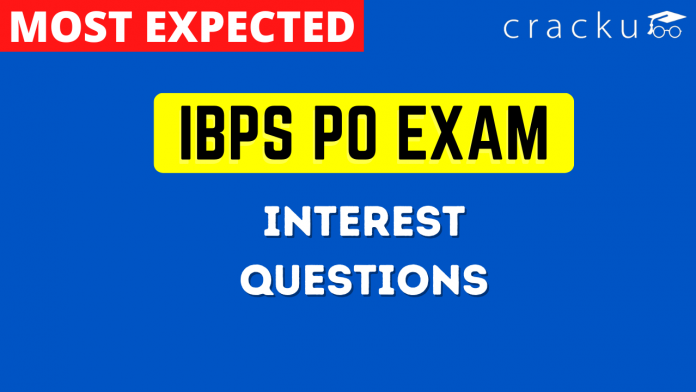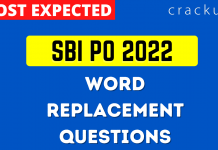IBPS PO Prelims Interest Questions PDF [Important]
One Interest is one of the key topics in the IBPS PO Prelims exam. Here you can download free Interest questions PDF with answers for IBPS PO Prelims 2022 by Cracku. These questions will help you to practice and solve the Interest questions in the IBPS PO exams. Utilize this best PDF practice set which includes the answers in detail. Click on the below link to download the Interest Usage MCQ questions PDF for IBPS PO Prelims 2022 for Free.
Download Interest Questions for IBPS PO Prelims
Download IBPS PO Previous Papers
Question 1: Atul borrowed a sum of ₹12000 and agreed to repay it by paying ₹4800 at the end of first year and ₹9240 at the end of second year. Whatis the rate of compound interest compounded annually?
a) 10%
b) 8%
c) 12%
d) $\frac{8}{5}\%$
1) Answer (A)
Question 2: A person borrowed a sumof ₹30800 at 10% p.a. for 3 years, interest compounded annually. At the end of twoyears, he paid a sumof ₹13268. At the end of 3rd year, he paid ₹ x to clear of the debt. What is the value of x ?
a) 26400
b) 26510
c) 26200
d) 26620
2) Answer (A)
Question 3: An amount of Rs. 38000 was deposited on the simple interest at the rate of 9% per annum for two years and another amount of Rs. 42000 was deposited on the compound interest at the rate of 12% per annum for one year compounded half-yearly. Find out the total interest obtained from both of the amounts.
a) Rs. 12497.2
b) Rs. 12262.2
c) Rs. 12031.2
d) Rs. 12656.2
3) Answer (C)
Solution:
An amount of Rs. 38000 was deposited on the simple interest at the rate of 9% per annum for two years.
Interest = $\frac{38000\times9\times2}{100}$
= 6840
Another amount of Rs. 42000 was deposited on the compound interest at the rate of 12% per annum for one year compounded half-yearly.
Interest = 42000 of 106% of 106% – 42000
= $42000\times1.06\times1.06 – 42000$
= 47191.2 – 42000
= 5191.2
Total interest = 6840+5191.2
= Rs. 12031.2
Hence, option c is the correct answer.
Question 4: An amount of Rs. 56000 was deposited for 1.5 years at 18% rate of interest per annum compounded half-yearly. Find out the interest obtained from it.
a) Rs. 16185.236
b) Rs. 16363.412
c) Rs. 16521.624
d) Rs. 16942.848
4) Answer (C)
Solution:
Here the interest is compounded half yearly. It means a 9% rate of interest for six months.
Interest = 56000 of 109% of 109% of 109% – 56000
= $56000\times1.09\times1.09\times1.09 – 56000$
= 72521.624 – 56000
= Rs. 16521.624
Hence, option c is the correct answer.
Question 5: Find the difference between the Compound and Simple Interest for a sum of Rs 1000 at a 10% rate of interest per annum for 2 years.
a) Rs 10
b) Rs 20
c) Rs 100
d) None of the above
5) Answer (A)
Solution:
The difference between the Compound and Simple Interest for 2 years is given as =
$P\times (\dfrac{R}{100})^2$, where P is Principle amount and R is the rate of interest.
Here P = Rs 1000 and R = 10%
From the above formula, we get the difference between Ci and SI for two years
= $1000\times (\dfrac{10}{100})^2$
Rs 10.
Question 6: A sum of money doubles itself in 15 years. By how much time it will become 8 times at Compound Interest?
a) 50 years
b) 40 years
c) 45 years
d) None of the above
6) Answer (C)
Solution:
If money will become m times in n years.
So, $m^n$ times in n x number of years
2 times will become in 15 years
So, $2^3$ will become double in 3 x 15 years = 45 years.
Question 7: What will be the approximate compound interest on a sum of Rs. 16500 invested for 3 years at the rate of 15% per annum compounded annually?
a) Rs.8418
b) Rs.8594
c) Rs.8680
d) Rs.8742
7) Answer (B)
Solution:
Compound interest = $P(1+\frac{R}{100})^{n} – P$
= $16500(1+\frac{15}{100})^{3} – 16500$
= $16500(\frac{115}{100})^{3} – 16500$
= $16500\times1.15^{3} – 16500$
= $16500\times 1.520875 – 16500$
= $16500( 1.520875 – 1)$
= $16500 \times0.520875$
= 8594.4375
= Rs.8594 (approx.)
Hence, option b is the correct answer.
Question 8: The difference between the simple interest and the compound interest earned on a certain sum of money at 15% per annum for 2 years is Rs.558. Find the difference between the simple interest and the compound interest earned on the same sum of money at 20% per annum for 2 years.
a) Rs.1116
b) Rs.992
c) Rs.948
d) Rs.864
8) Answer (B)
Solution:
Let the sum invested be Rs.10000x.
Simple interest earned on Rs.10000x at 15% per annum for 2 years = $\dfrac{10000x\times15\times2}{100} = Rs.3000x$.
Amount earned after 2 years at compound interest = $10000x\times\dfrac{115}{100}\times\dfrac{115}{100} = Rs.13225x$.
Compound interest = Rs.13225x – Rs.10000x = Rs.3225x.
Given, 3225x – 3000x = Rs.558.
225x = 558
x = 2.48
Hence, The sum invested = Rs.10000x = Rs.24800.
Simple Interest earned on Rs.24800 at 20% per annum = $\dfrac{24800\times20\times2}{100} = Rs.9920$.
Amount earned after 2 years at 20% per annum compound interest = $24800\times1.2\times1.2 = Rs.35712$.
Compound interest = Rs.35712 – Rs.24800 = Rs.10912.
Hence, The required difference = Rs.10912 – Rs.9920 = Rs.992.
Question 9: If the simple interest earned on a sum of Rs.x at 12.5% per annum for ‘t’ years is the same as the simple interest earned on a sum of Rs.y at 16.67% per annum for ‘2t’ years, then find the ratio between the sum invested at 12.5% per annum and 16.67% per annum respectively.
a) 7:5
b) 6:7
c) 8:3
d) 4:1
9) Answer (C)
Solution:
Sum = Rs.x
Rate of interest = 12.5% per annum.
Time period = ‘t’ years.
Sum = Rs.y
Rate of interest = 16.67% per annum.
Time period = 2t years.
$\dfrac{x\times12.5\times t}{100} = \dfrac{y\times16.67\times2t}{100}$
$\dfrac{x\times1}{8} = \dfrac{y\times2}{6}$
$\dfrac{x}{8} = \dfrac{y}{3}$
Hence, x:y = 8:3.
Question 10: Find the compound interest on Rs 7540 at 8% per annum for 1 year, when compounded half yearly.
a) Rs. 454.66
b) Rs. 254.66
c) Rs. 615.264
d) Rs. 554.664
10) Answer (C)
Solution:
According to the question,
Rate = 8%,
Principal = Rs 7540
Time = 2 half years
Compound Interest = $P[(1+\frac{r}{200})^2 – 1]$
CI = $7540[(1+\frac{8}{200})^2 – 1]$
CI = $7540[(\frac{208}{200})^2 – 1]$
CI = $7540 \times (\frac{43264}{40000}-1)$, solving this we get,
CI = Rs. 615.264.
Question 11: A man invested 50% of his capital money at 8% per annum, 25% of his capital money at 6% per annum and the remaining capital money he invested at 10% per annum at simple interest. If at the end of a year he receives the total interest of Rs 450, then find the overall capital money he invested.
a) Rs 5400
b) Rs 4500
c) Rs 5256
d) Rs 5625
11) Answer (D)
Solution:
According to the question,
Let his capital be x
So,
50% of x = x/2
Simple Interest = $\frac{ x . 8 . 1}{200}$
25% of x = x/4
Simple interest = $\frac{x . 6 . 1}{400}$
Remaining amount = x/4
Simple interest = $\frac{x . 10 . 1}{400}$
Now on adding
$\frac{ x . 8 . 1}{200}$ + $\frac{x . 6 . 1}{400}$ + $\frac{x . 10 . 1}{400}$ = 450
$\frac{ x . 8 . 1}{200}$ + $\frac{x . 3 . 1}{200}$ + $\frac{x . 5 . 1}{200}$ = 450
8x + 3x + 5x = 90000
16x = 90000
X = 5625
So his investment = Rs 5625
Question 12: If the sum of money kept in compound interest triple itself in 3 years, then find the time taken by it to be 9 times of itself.
a) 9 years
b) 6 years
c) 5 years
d) 12 years
12) Answer (B)
Solution:
According to the question,
Amount = $Principal(1 + \frac{rate}{100})^{time}$
Amount gets double in three years so,
3 x Amount = $Principal(1 + \frac{rate}{100})^{3}$
Amount gets 9 times in,
3 x 3 x Amount = $Principal(1 + \frac{rate}{100})^{n}$
We know,
$(Principal(1 + \frac{rate}{100})^{3})^2$ = $Principal(1 + \frac{rate}{100})^{n}$
So
N = 6 years
Question 13: If the compound interest for the third year at 9.09% per annum compounded annually is Rs.720. Find the principal.
a) Rs.8575
b) Rs.6655
c) Rs.4875
d) Rs.6425
13) Answer (B)
Solution:
9.09% = $\dfrac{1}{11}$.
Let the Principal be Rs.1331P.
Amount after the first year = $1331P\times\dfrac{12}{11} = Rs.1452P$.
Principal for the second year = Rs.1452P.
Amount after the second year = $1452P\times\dfrac{12}{11} = Rs.1584P$.
Principal for the third year = Rs.1584P.
Amount after the third year = $1584P\times\dfrac{12}{11} = Rs.1728P$.
Interest for the third year = 1728P – 1584P = Rs.144P.
Given, 144P = 720 ⇒ P = 5.
Hence, Principal = Rs.1331P = Rs.6655.
Question 14: The rate of interest at which a certain sum of money at simple interest amounts to Rs.18174 in 2 years and Rs.22035 in 5 years is:
a) 8.25%
b) 6.75%
c) 6.67%
d) 15%
14) Answer (A)
Solution:
Given, Amount for 2 years = Rs.18174.
Amount for 5 years = Rs.22035.
Then, Simple Interest for 3 years = Rs.22035 – Rs.18174 = Rs.3861.
Simple Interest for 2 years = $\dfrac{2\times3861}{3} = Rs.2574$.
Principal = Amount for 2 years – Simple Interest for 2 years = Rs.18174 – Rs.2574 = Rs.15600.
Let the rate of interest be R%.
$\dfrac{15600\times R\times2}{100} = 2574$
$312R = 2574$
$R = 8.25\%$
Question 15: A certain sum of money amounts to Rs.14725 at 6.25% per annum simple interest in 3 years. What approximate interest would have been obtained if the same sum is invested at the same rate of compound interest in the same time period?
a) Rs.2583
b) Rs.2473
c) Rs.2613
d) Rs.2437
15) Answer (B)
Solution:
Let the principal be Rs.P.
Rate of interest = 6.25%.
Time period = 3 years.
Interest = Rs.14725 – P.
$\dfrac{P\times6.25\times3}{100} = 14725 – P$
$0.1875P = 14725-P$
$1.1875P = 14725$
$P = Rs.12400$
If Rs.12400 is invested at compound interest,
Amount after three years = $12400\times\dfrac{106.25}{100}\times\dfrac{106.25}{100}\times\dfrac{106.25}{100}$
$\approx 14873$
Hence, Interest = 14873 – 12400 = Rs.2473.
Question 16: A loan was repaid in two equal instalments of Rs.51577.5 each in two years. If the rate of interest is 15% compounded annually, then the difference between the amount of loan taken and the total interest paid is:
a) Rs.64895
b) Rs.64545
c) Rs.68750
d) Rs.65800
16) Answer (B)
Solution:
Let Principal = Rs.x.
Total amount repaid = 51577.5 $\times$2 = Rs.103155
Loan amount = $\dfrac{51577.5}{1.15}+\dfrac{51577.5}{1.15\times1.15} = 44850+39000 = Rs.83850$.
Total interest paid = 103155 – 83850 = 19305.
Hence, Required difference = 83850 – 19305 = Rs.64545.
Question 17: A certain sum of money amounts to Rs.101167.5 in 4 years 6 months at 7.69% per annum simple interest. Find the interest obtained by the same sum of money at 15.38% per annum simple interest for 6.8 years.
a) Rs.78621.6
b) Rs.72186.6
c) Rs.76218.6
d) Rs.71626.8
17) Answer (A)
Solution:
7.69% = $\dfrac{1}{13}$
Let the principal be Rs.65P.
Given, $\dfrac{65P\times4.5}{13} + 65P = 101167.5$
$22.5P+65P = 101167.5$
$87.5P = 101167.5$
P = 1156.2.
Then, Principal = 65P = Rs.75153.
Rate of interest = 15.38% = $\dfrac{2}{13}$
Time period = 6.8 years.
Interest = $\dfrac{75153\times2\times6.8}{13} = Rs.78621.6$.
Question 18: Which of the following yields the highest interest of all when invested for 2 years?
I. Rs.24000 invested at 12.5% per annum Simple Interest.
II. Rs.19440 invested at 11.11% per annum Compound interest compounded annually.
III. Rs.28750 invested at 10% per annum compounded half-yearly.
a) Only I
b) Both II and III
c) Only III
d) Both I and III
18) Answer (C)
Solution:
I. Principal = Rs.24000
Rate of interest = 12.5%
Time period = 2 years.
Interest = $\dfrac{24000\times12.5\times2}{100} = Rs.6000$.
II. Principal = Rs.19440
Rate of interest = 11.11% = $\dfrac{1}{9}$
Amount after two years = $19440\times\dfrac{10}{9}\times\dfrac{10}{9} = Rs.24000$
Interest = Rs.24000-19440 = Rs.4560.
III. Principal = Rs.28750.
Rate of interest = 10% per annum compounded half-yearly.
Amount after two years = $28750\times1.05\times1.05\times1.05\times1.05 = Rs.34945.8$.
Interest = Rs.34945.8 – Rs.28750 = Rs.6195.8
Hence, Option C is the correct answer.
Question 19: A person invested a certain sum of money at 15% Simple interest per annum for three years. He then withdraws the whole amount and invested the whole amount in a scheme which offers 20% per annum for the first year and 10% per annum for the second year. He withdraws the whole amount which is equal to Rs.5742. What is the sum which he invested initially?
a) Rs.2500
b) Rs.3000
c) Rs.4000
d) Rs.4500
19) Answer (B)
Solution:
Let the initial investment be Rs.x.
Amount after 3 years = $\dfrac{x\times15\times3}{100}+x = Rs.1.45x$
Amount after next two year = $1.45x\times1.2\times1.1 = Rs.1.914x$.
Given, 1.914x = 5742
x = $\dfrac{5742}{1.914} = 3000$
Hence, Option B is the correct answer.
Question 20: In approximately how many years will a certain sum of money become 21 times of itself at 7% per annum Compound interest compounded annually?
a) 45 years
b) 84 years
c) 68 years
d) 39 years
20) Answer (A)
Solution:
Let the sum of money be Rs.x
Let the time period be ‘T’ years.
Amount after T years = Rs.343x
$x\times\dfrac{107}{100}^T = 21x$
$\dfrac{107}{100}^T = 21$
$1.07^T = 21$
From the options,
A) $1.07^\text{45} \approx 21$
B) $1.07^\text{84} \approx 294$
C) $1.07^\text{68} \approx 100$
D) $1.07^\text{39} \approx 14$
Hence, Option A is the correct answer.



![SBI PO Puzzles Questions PDF [Most Important] _ Puzzles Questions](https://cracku.in/blog/wp-content/uploads/2022/10/Puzzles-Questions--218x150.png)

